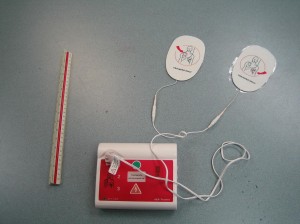Most of us are familiar on what a defibrillator or AED looks like and how it is used since it is seen on TV shows and movies. You can even learn how to use one by enrolling in a first aid course in order to be prepared to save lives during emergencies. Always bear in mind that the main purpose of the device is to correct or improve an abnormal heart rhythm that becomes life-threatening by delivering a series of electrical shocks. Nevertheless, there are cases in which a defibrillator is contraindicated or using one is not advisable.
When placing the defibrillator paddles on the individual who has no pulse, no else must be touching the individual once the device is turned on or they will also receive an electrical shock. You have to shout “CLEAR” before delivering the electrical shock as a warning to bystanders to move away from the individual. Additionally, if the victim is a woman, the breasts must not be touched by the paddles since it is not needed and can even interfere with the distribution of the current. If the victim is a woman, the bra must be removed and placed loosely on the neck.
Cases when using a defibrillator should be avoided
These are scenarios in which an AED or defibrillator should not be used or care must be observed.
Conscious and alert individual
A defibrillator must not be used on an individual who is conscious or has a pulse even if it is erratic but not life-threatening. In case the individual has a pulse, delivering a shock can cause an opposite effect and result to a life-threatening abnormal heart rhythm or even cardiac arrest. If the individual is unconscious and not breathing, but has a pulse, CPR should only be performed by a qualified individual.

Implanted defibrillator
In case the individual has an implanted defibrillator that is surgically placed, using an external defibrillator is contraindicated unless the implant is not functional. If the implanted device is not working, the external defibrillator can be used normally. Take note that a shock given by an external device will not harm the implant, but if both are working and used at the same time, it can cause problems due to the excess voltage produced.
Wet surfaces
It is important that the chest of the individual is properly dried before applying the paddles or it can affect the distribution of the current. In case the individual is lying on a wet surface, he/she must be transferred away unless it is considered an unsafe action in which all bystanders must leave the wet area. Take note that the bystanders can get shocked once the device is turned on. If the defibrillator is used, using latex gloves can help minimize the effect of any shock in wet conditions.
